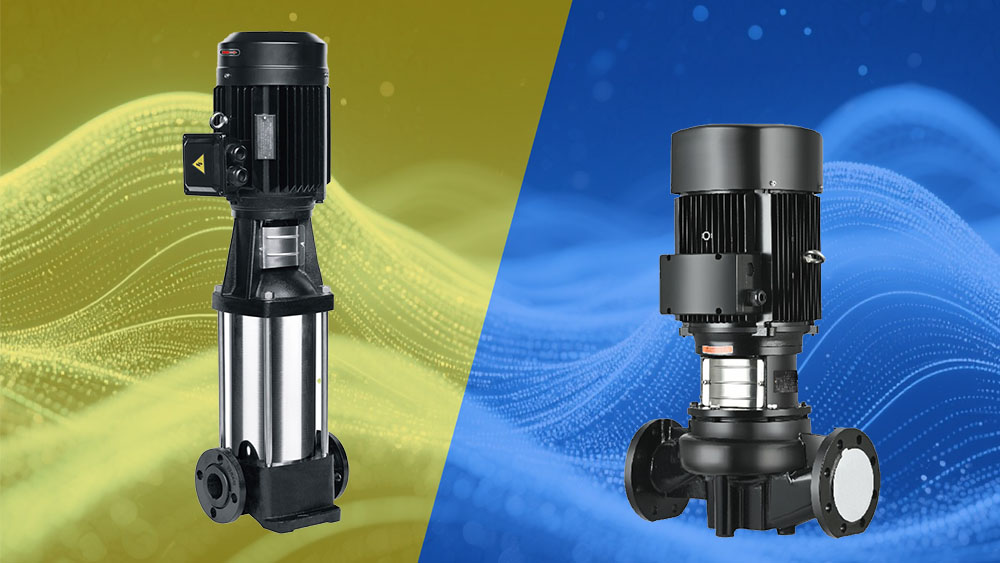+86 13816508465
Jul. 22, 2025

Pressure boosting systems play a vital role in maintaining efficient pipeline performance across residential, commercial, and industrial applications. Selecting the right pipeline booster pump is crucial to ensure consistent pressure, optimal energy consumption, and system reliability. The two primary contenders for this role are inline pumps (pipeline pumps) and vertical multistage pumps. Each pump type has unique strengths and fits specific application scenarios.
This guide will help you understand the key differences between these pump types and how to choose the best option based on your system's pressure requirements, space constraints, and budget.
What Are Inline (Pipeline) Pumps?
Inline pumps, often called pipeline pumps, are designed to be installed directly within the pipeline they serve. Compact and straightforward to integrate, these pumps excel in applications requiring moderate pressure boosting without significant modifications to existing systems.
How Inline Pumps Work
An inline pump is installed horizontally within the pipeline framework. It functions by boosting the pressure of the fluid moving through the pipe, keeping the system efficient and stable, especially in closed-loop systems like HVAC and water circulation.
Common Use Cases for Inline Pumps
HVAC circulation loops
Low to moderate pressure boosting in residential and commercial plumbing
Tight installation spaces, where horizontal setup is necessary
Advantages of Inline Pumps
Easy Installation
Inline pumps attach directly to existing pipelines, minimizing installation costs and avoiding major redesigns.
Compact, Space-Saving Design
Their small footprint makes them ideal for tight spaces or setups with limited horizontal room.
Lower Upfront Costs
Inline pumps are generally more affordable than other options, making them attractive for budget-conscious projects.
Disadvantages of Inline Pumps
Limited Pressure Capabilities
Inline pumps are best for systems requiring a moderate pressure head and are not suited for high-pressure applications.
Maintenance Complications
Servicing these pumps often necessitates shutting down the pipeline, which can be a challenge in critical operations.
Less Efficient for High-Demand Tasks
When consistent high pressure or heavy-duty demand is needed, inline pumps may fall short.
What Are Vertical Multistage Pumps?
Vertical multistage pumps use a series of impellers stacked vertically to generate high pressure within a compact footprint. These pumps are ideal for environments where vertical space is available, and the demand for pressure is continuously high.
How Vertical Multistage Pumps Work
Each impeller in the vertical setup increases the pressure of the fluid as it passes through, enabling these pumps to handle significant pressure demands efficiently.
Common Use Cases for Vertical Multistage Pumps
High-rise building water supply systems
Industrial processes, including reverse osmosis (RO) and boiler feed applications
Applications with high pressure and flow rate requirements
Advantages of Vertical Multistage Pumps
High-Pressure Output
Thanks to their multistage configuration, these pumps deliver excellent pressure performance.
Energy Efficiency
Vertical multistage pumps are designed for efficiency, particularly in systems requiring continuous operation.
Compact Vertical Design
They save horizontal space while delivering the power needed for demanding systems.
Disadvantages of Vertical Multistage Pumps
Higher Installation Complexity
These pumps require careful setup, often involving a base plate or suction tank, adding to the initial effort and cost.
Greater Initial Investment
Vertical multistage pumps are more expensive upfront but often justify the cost with long-term efficiency savings.
Vertical Space Requirements
If your system lacks sufficient vertical clearance, these pumps may not be a viable option.
To identify the best pipeline booster pump for your situation, weigh the following considerations:
1. Required Pressure Head and Flow Rate
Use inline pumps for low to medium pressure applications.
Opt for vertical multistage pumps for high-pressure, high-flow systems.
2. Available Space
Inline pumps fit horizontally, making them ideal for compact installations.
Vertical multistage pumps require upright clearance but economize on horizontal space.
3. System Complexity
Simpler setups, such as closed-loop systems, often benefit from inline pumps.
For more complex and demand-heavy applications, vertical multistage pumps excel.
4. Energy Efficiency Goals
If energy efficiency and lower operational costs are priorities, consider vertical multistage pumps.
5. Budget
Factor in both the initial cost and the long-term cost of ownership. While inline pumps are cheaper upfront, vertical multistage pumps offer better efficiency over time.
6. Maintenance Access
Inline pumps may require a pipeline shutdown for maintenance, which can be disruptive.
Vertical multistage pumps often provide easier access for servicing due to their external configuration.
To simplify your decision-making process, here's a comparison of when to use each pump type:
Scenario | Recommended Pump | Why |
Small residential booster systems | Inline Pump | Quicker installation, sufficient for moderate pressure demands. |
Commercial buildings with floors | Vertical Multistage Pump | etter for high-pressure needs and energy savings over time. |
Industrial pressure boosting | Vertical Multistage Pump | Reliable for heavy-duty, continuous high-pressure operations. |
Tight, horizontal installations | Inline Pump | Fits snugly in horizontal spaces without redesigning the system layout. |
Selecting the optimal pipeline booster pump requires balancing your system's exact needs with practical considerations like space, budget, and maintenance. There is no 【 one-size-fits-all 】option; the correct pump type depends on specific application demands.
For low to medium pressure systems with straightforward requirements, inline pumps make a reliable, cost-effective choice. On the other hand, vertical multistage pumps provide unmatched performance for high-pressure scenarios, excelling in energy efficiency and durability.
TIP: For tailored advice, consult with pump specialists or suppliers to find the ideal solution for your unique setup.
Address
No.17 XeDa Jimei Ind. Park, Xiqing Economic Development Area, Tianjin, China
Telephone
+86 13816508465
QUICK LINKS